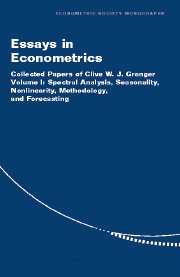Book contents
- Frontmatter
- Contents
- Acknowledgments
- List of Contributors
- Introduction
- 1 The ET Interview: Professor Clive Granger
- PART ONE SPECTRAL ANALYSIS
- PART TWO SEASONALITY
- PART THREE NONLINEARITY
- PART FOUR METHODOLOGY
- PART FIVE FORECASTING
- 17 Estimating the Probability of Flooding on a Tidal River
- 18 Prediction with a Generalized Cost of Error Function
- 19 Some Comments on the Evaluation of Economic Forecasts
- 20 The Combination of Forecasts
- 21 Invited Review: Combining Forecasts – Twenty Years Later
- 22 The Combination of Forecasts Using Changing Weights
- 23 Forecasting Transformed Series
- 24 Forecasting White Noise
- 25 Can We Improve the Perceived Quality of Economic Forecasts?
- 26 Short-Run Forecasts of Electricity Loads and Peaks
- Index
20 - The Combination of Forecasts
Published online by Cambridge University Press: 06 July 2010
- Frontmatter
- Contents
- Acknowledgments
- List of Contributors
- Introduction
- 1 The ET Interview: Professor Clive Granger
- PART ONE SPECTRAL ANALYSIS
- PART TWO SEASONALITY
- PART THREE NONLINEARITY
- PART FOUR METHODOLOGY
- PART FIVE FORECASTING
- 17 Estimating the Probability of Flooding on a Tidal River
- 18 Prediction with a Generalized Cost of Error Function
- 19 Some Comments on the Evaluation of Economic Forecasts
- 20 The Combination of Forecasts
- 21 Invited Review: Combining Forecasts – Twenty Years Later
- 22 The Combination of Forecasts Using Changing Weights
- 23 Forecasting Transformed Series
- 24 Forecasting White Noise
- 25 Can We Improve the Perceived Quality of Economic Forecasts?
- 26 Short-Run Forecasts of Electricity Loads and Peaks
- Index
Summary
Two separate sets of forecasts of airline passenger data have been combined to form a composite set of forecasts. The main conclusion is that the composite set of forecasts can yield lower mean-square error than either of the original forecasts. Past errors of each of the original forecasts are used to determine the weights to attach to these two original forecasts in forming the combined forecasts, and different methods of deriving these weights are examined.
INTRODUCTION
Our interest is in cases in which two (or more) forecasts have been made of the same event. Typically, the reaction of most statisticians and businessmen when this occurs is to attempt to discover which is the better (or best) forecast; the better forecast is then accepted and used, the other being discarded. Whilst this may have some merit where analysis is the principal objective of the exercise, this is not a wise procedure if the objective is to make as good a forecast as possible, since the discarded forecast nearly always contains some useful independent information. This independent information may be of two kinds:
(i) One forecast is based on variables or information that the other forecast has not considered.
(ii) The forecast makes a different assumption about the form of the relationship between the variables.
The second case in particular does not necessarily lead to a situation in which a combined forecast improves upon the better individual forecast, though there are occasions when it can, as is shown in Section 1 of the Appendix.
- Type
- Chapter
- Information
- Essays in EconometricsCollected Papers of Clive W. J. Granger, pp. 391 - 410Publisher: Cambridge University PressPrint publication year: 2001
- 9
- Cited by



